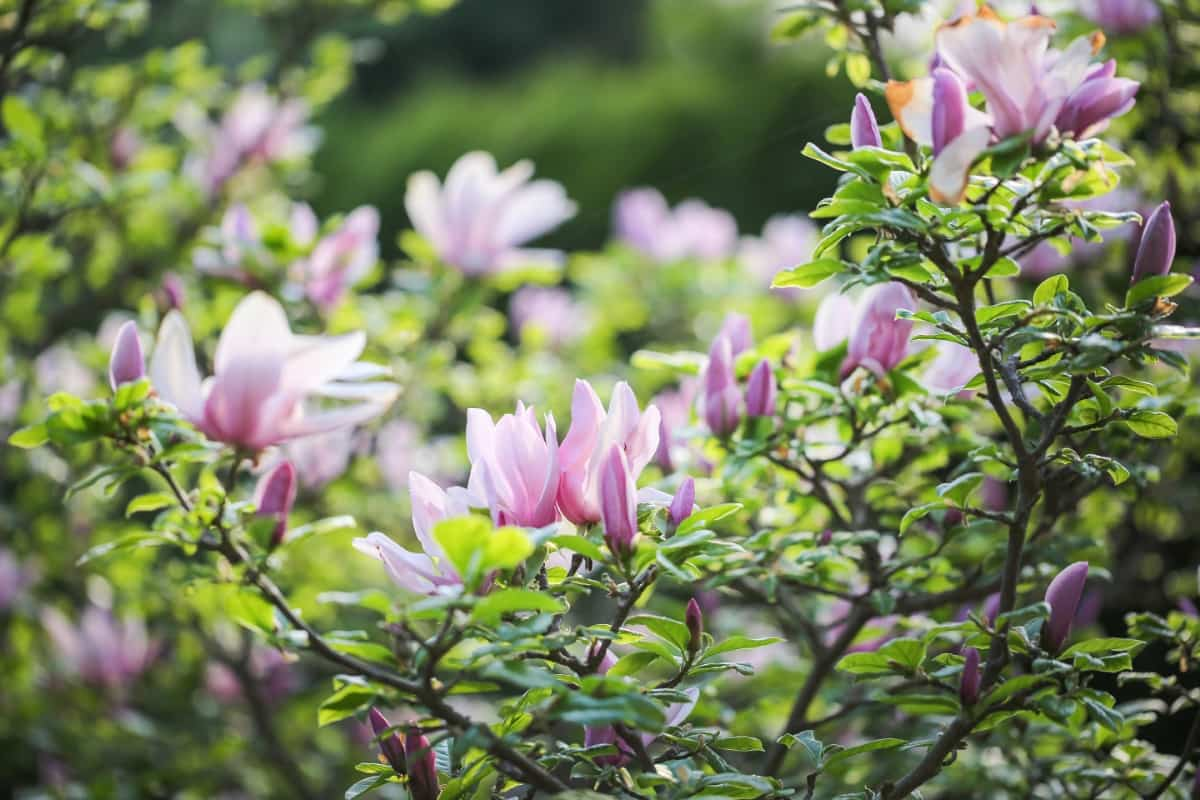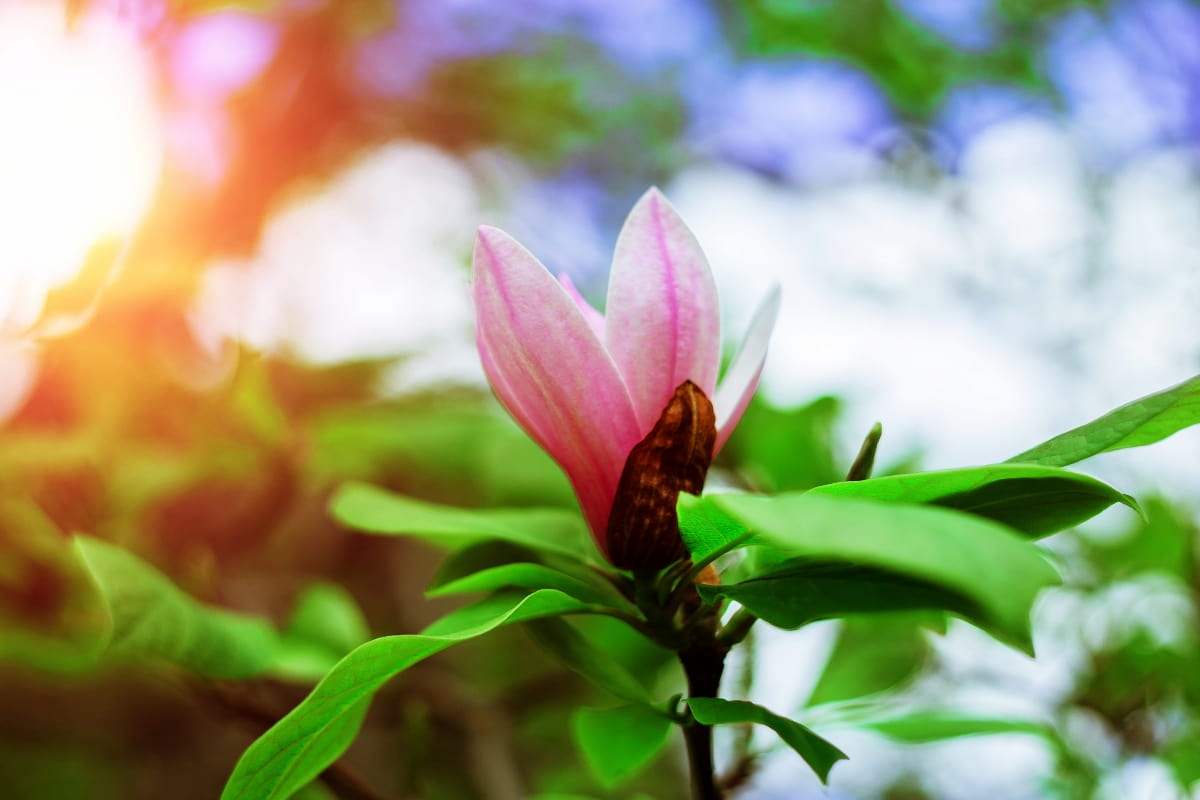Magnolia trees are beautiful and fragrant additions to any garden, but they can also attract various pests that can damage their leaves, flowers, and branches. This blog article will discuss controlling magnolia problems with natural and organic treatment techniques that are secure for the environment, your plants, and you.

How to Control Magnolia Pests Naturally
Understanding Magnolia Pests: Identifying Common Pests and Their Damage
Before effectively controlling magnolia pests, you must know what kind of pests you are dealing with and what damage they cause.
- Scale insects: Small, sap-sucking insects that attach to magnolia stems and leaves. They secrete honeydew, causing yellowing, wilting, and stunted growth.
- Aphids: Like scale insects, they feed on new growth and buds, producing honeydew. They cause curling, distortion, and discoloration of leaves and flowers.
- Mealybugs: White, fuzzy insects that feed on sap and produce honeydew, causing leaf drop and branch dieback.
- Trips: Tiny, winged insects that cause brown spots, streaks, and scars on petals.
- Caterpillars: moth and butterfly larvae that eat leaves and flowers, causing holes, notches, skeletonization, and defoliation.
- Beetles: Hard-shelled insects that chew on leaves, flowers, and bark, causing cavities, ragged edges, girdling, and bark splitting.
Prevention is Key: Implementing Effective Strategies to Control Magnolia Pests
- Choose resistant varieties: Research different varieties like star magnolia (Magnolia stellata) and southern magnolia (Magnolia grandiflora) for specific pests.
- Plant in the right location: Full sun or partial shade, well-drained soil, and adequate space are essential. Avoid planting in wet, poorly drained, or compacted soil.
- Proper pruning: Improve air circulation, light penetration, shape, and vigor of magnolias. Don’t prune in the early spring or late winter.
- Regular inspection: Look for signs of pest activity or damage, such as insects, eggs, webs, honeydew, sooty mold, and holes.
Natural Remedies for Magnolia Pest Control: Harnessing the Power of Companion Planting
Companion planting is a natural and effective method for controlling magnolia pests. It involves growing plants that benefit each other in terms of pest control, nutrient uptake, pollination, and aesthetics.
- Garlic: Deter aphids, thrips, and beetles from magnolias.
- Plant garlic cloves around the base of magnolia trees or intercrop them.
- Make a garlic spray by blending garlic cloves with water.
- Marigolds: Attract beneficial insects and repel nematodes.
- Plant marigolds near magnolia trees or in pots.
- Use marigold petals to make a tea for watering magnolias.
- Lavender: Repellent herb repels moths, butterflies, and caterpillars.
- Plant lavender around trees or borders.
- Use lavender oil to make a spray.
- Mint: Repellent herb protects magnolias from scale insects and aphids.
- Plant mint near trees or in pots.
In case you missed it: How to Control Amaryllis Pests Naturally: How to Get Rid of Them with Natural and Organic Treatment

Organic Treatments for Magnolia Pests: Utilizing Safe and Environmentally Friendly Solutions
Neem Oil: An infusion made from neem tree seeds, native to India, has insecticidal, fungicidal, and antibacterial properties. It can kill or repel pests like scale insects, aphids, thrips, caterpillars, and beetles. It also interferes with insect hormonal systems.
Diatomaceous earth: The refined powder derived from the decomposed residues of diatoms, effective against soft-bodied pests like aphids, thrips, caterpillars, and beetles. It can be purchased from garden centers or online stores.
Bacillus thuringiensis (Bt): A bacterium that produces toxins lethal to certain insects, especially caterpillars. It can be bought from garden centers or online stores. It should be applied when signs of caterpillar activity or damage are seen.
Creating a Healthy Garden Ecosystem: Attracting Beneficial Insects to Combat Magnolia Pests
To control magnolia pests, create a healthy garden ecosystem with beneficial insects that feed on or parasitize pests, pollinate plants, enhance soil fertility, and decompose organic matter.
- Planting flowering plants like daisies, sunflowers, and zinnias for nectar and pollen.
- Planting small-flowering herbs like basil, oregano, or thyme.
- Installing water sources like birdbaths, fountains, shallow dishes, or wet areas near plants.
- Providing shelter for beneficial insects to hide from predators, rest, or overwinter.
Homemade Pest Repellents: DIY Recipes to Deter Magnolia Pests Naturally
Magnolias, a beautiful and fragrant tree, are susceptible to various pests such as aphids, scale insects, mealybugs, caterpillars, and borers. Commercial pesticides can harm beneficial insects and the environment. DIY recipes offer a natural solution to deter pests.
- Garlic Spray: Natural insect repellent from boiling garlic cloves in water. Spray once a week or after rain.
- Neem Oil Spray: Organic oil extracted from neem tree seeds. It has insecticidal and fungicidal properties.Mix two teaspoons of neem oil and one teaspoon of liquid soap.Spray on leaves and stems, repeating every 7 to 14 days.
- Chili Pepper Spray: Compound from chili peppers irritates insect and mammal sensory organs.Mix with hot peppers, strain, and spray.
Physical Barriers and Traps: Physical Methods to Keep Magnolia Pests at Bay
Another way to prevent or reduce magnolia pest infestations is to use physical barriers and traps that exclude or capture the pests before they reach your plants.
- Netting: Use fine mesh or bird netting to protect magnolias from insects, birds, and animals. Secure netting around the tree base to prevent gaps.
- Sticky Traps: Use yellow sticky traps to attract and catch flying insects like aphids, whiteflies, and leafhoppers. Hang traps near magnolias and replace them when complete or dirty.
- Borer Traps: Wrap corrugated cardboard around the trunk or branches of magnolias in late spring or early summer to trap borers. Remove and destroy cardboard every few weeks.
Soil Management Techniques: Enhancing Soil Health to Reduce Magnolia Pest Infestations
The health of your soil plays a vital role in the health of your magnolias. Healthy soil can provide adequate nutrients, water, air, and beneficial microorganisms to your plants, making them more resilient to pests and diseases.
- Mulching: Creates a barrier against soil-borne pests.Mulch should be used in a 2- to 4-inch layer around magnolias.
- Composting: Improves soil fertility and quality. Helps recycle organic materials. Introduces beneficial microorganisms to soil. Apply compost before planting or as a top dressing for magnolias.
- Crop Rotation: Prevents pest and disease buildup. Improves soil fertility and diversity. More applicable to annual or biennial plants than perennial plants.
In case you missed it: How to Control Tulip Pests Naturally: How to Get Rid of Them with Natural and Organic Treatment

Proper Watering and Fertilization Practices: Maintaining Vigorous Magnolias to Resist Pests
One of the best ways to prevent or reduce magnolia pest infestations is to maintain vigorous and healthy plants that can resist or tolerate pest attacks. To prevent pests and diseases, magnolias require regular deep watering, especially during dry periods. Watering helps establish robust root systems, cope with environmental stress, and flush out salts and toxins from the soil.
Avoid overwatering or underwatering to prevent root problems. Fertilization, once a year in early spring, supports growth and flowering, enhancing color, fragrance, and resistance to pests. Avoid overfertilizing or underfertilizing to avoid nutrient imbalances and stress.
Integrated Pest Management (IPM) for Magnolias: A Holistic Approach to Pest Control
Integrated pest management (IPM) is a holistic approach to pest control that combines various methods of prevention, monitoring, and intervention to manage pest populations below damaging levels while minimizing the use of pesticides. Pests pose a significant threat to magnolias, necessitating effective pest management strategies.
Prevention involves selecting pest-resistant varieties, planting healthy, disease-free plants, and maintaining optimal growing conditions. Monitoring involves identifying pests and their natural enemies, assessing damage, and evaluating control measures. Intervention, on the other hand, involves reducing pest populations to below damaging levels when necessary, using methods like hand-picking, pruning, washing, vacuuming, and applying biological, botanical, or synthetic pesticides.
Magnolia Pest and their Control with Natural and Organic Treatment
| Pest | Natural/Organic Control |
| Aphids | Spray with a mixture of water and dish soap. Introduce ladybugs, lacewings, or parasitic wasps to prey on aphids. Neem oil spray. |
| Scale Insects | Prune and remove heavily infested branches. Apply horticultural oil in late winter or early spring to suffocate scale insects. |
| Magnolia Weevil | Handpick and destroy adult weevils. – Beneficial nematodes in the soil to control larvae. |
| Leaf miners | Prune and dispose of affected leaves. Introduce parasitic wasps to control larvae. Neem oil spray. |
| Magnolia Scale | Prune and remove heavily infested branches. Apply horticultural oil in late winter or early spring |
| Whiteflies | Spray with a mixture of water and dish soap. Release predatory insects like ladybugs and lacewings |
| Fungal Diseases | Ensure good air circulation and spacing between plants. Water the base of the plant to avoid wetting foliage. Apply copper-based fungicides or neem oil as a preventive measure |
| Bacterial Canker | Prune and dispose of infected branches. Promote overall plant health with proper watering and fertilization. Apply copper-based bactericides. |
| Sooty Mold | Control the insects that produce honeydew (e.g., aphids or whiteflies). Rinse affected leaves with water or a mild soapy solution. Improve overall plant health. |
| Snails and Slugs | Handpick and dispose of snails and slugs. Use organic snail and slug baits (iron phosphate-based) sparingly. Create barriers like copper tape to protect plants. |
In case you missed it: How to Control Lavender Pests Naturally: How to Get Rid of Them with Natural and Organic Treatment

Frequently Asked Questions on Controlling Magnolia Pests Naturally
What are the Common Pests That Affect Magnolia Trees?
Pests such as scale insects, aphids, mealybugs, spider mites, caterpillars, and borers pose significant threats to magnolia trees, causing various issues such as leaf curling, yellowing, wilting, and branch dieback.
How Can I Identify the Pests on My Magnolia Trees?
Regular inspection of magnolia trees is crucial for identifying pests, which can be detected using magnifying glasses or smartphone cameras.
Conclusion
Magnolia trees, despite their beauty, can attract pests that can damage their health and appearance. To combat this, natural and organic treatments can be used, ensuring the health and appearance of your plants without causing harm to the environment.
- Beneficial Insects in Pest Management
- Natural Solutions for Pest Control in Flower Gardens
- Types of Fungicides Used in Agriculture
- Common Issues in the Fruit Development Stage of Pomegranate Farming
- Fruit Development Issues in Papaya: Easy Solutions and Treatment
- Soil-Borne Diseases and How to Protect Your Plants
- Practices to Prevent Disease Spread in the Garden
- From Wilted to Thriving: How to Treat Root Rot Naturally in Houseplants
- Natural Remedies to Cure Brown Spots on Fig Tree Leaves